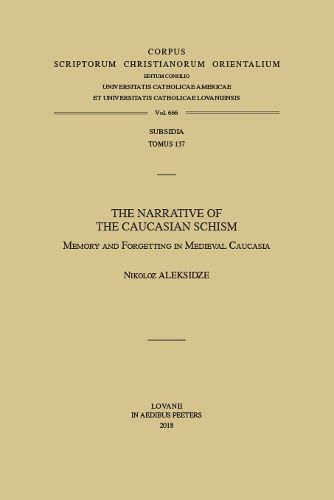Readings Newsletter
Become a Readings Member to make your shopping experience even easier.
Sign in or sign up for free!
You’re not far away from qualifying for FREE standard shipping within Australia
You’ve qualified for FREE standard shipping within Australia
The cart is loading…






In the early seventh century, the Georgian and the Armenian Churches
separated. Since then, the two nations formed their distinct Christian
cultures and national Churches. This also resulted in mutual antagonism,
the repercussions of which are still observable in modern Caucasia -
This is the prevalent narrative that one encounters in modern histories
of medieval Caucasia. In the centre of this narrative lies the Schism -
a watershed that divides the history of Caucasia into two chronological
constituents, the era before and after. Indeed, the Schism is allegedly
one of the most well documented events in Caucasian history, infinitely
evoked and referred to in medieval Armenian historical accounts. The
present study is an attempt to deconstruct this grand narrative by
focusing on the formation of the narrative of the Schism, its central
element. It argues that the narrative of the Schism was perpetually
reconstructed and reinvented by medieval historians for the purpose of
sustaining teleological continuity in their perception of the region’s
history. In the historical imaginaries of different medieval writers in
different times and places, the Schism served as an interpretive tool in
attempts to create a sound connection between the present and the
forgotten past. The Schism was once again reinvented in contemporary
Armenian and Georgia national discourses, and thence has made its way
into scholarly studies.
$9.00 standard shipping within Australia
FREE standard shipping within Australia for orders over $100.00
Express & International shipping calculated at checkout
In the early seventh century, the Georgian and the Armenian Churches
separated. Since then, the two nations formed their distinct Christian
cultures and national Churches. This also resulted in mutual antagonism,
the repercussions of which are still observable in modern Caucasia -
This is the prevalent narrative that one encounters in modern histories
of medieval Caucasia. In the centre of this narrative lies the Schism -
a watershed that divides the history of Caucasia into two chronological
constituents, the era before and after. Indeed, the Schism is allegedly
one of the most well documented events in Caucasian history, infinitely
evoked and referred to in medieval Armenian historical accounts. The
present study is an attempt to deconstruct this grand narrative by
focusing on the formation of the narrative of the Schism, its central
element. It argues that the narrative of the Schism was perpetually
reconstructed and reinvented by medieval historians for the purpose of
sustaining teleological continuity in their perception of the region’s
history. In the historical imaginaries of different medieval writers in
different times and places, the Schism served as an interpretive tool in
attempts to create a sound connection between the present and the
forgotten past. The Schism was once again reinvented in contemporary
Armenian and Georgia national discourses, and thence has made its way
into scholarly studies.